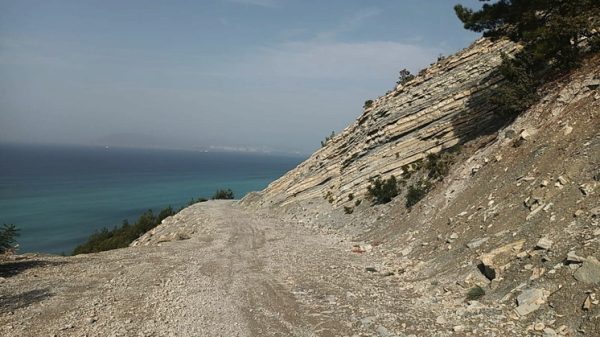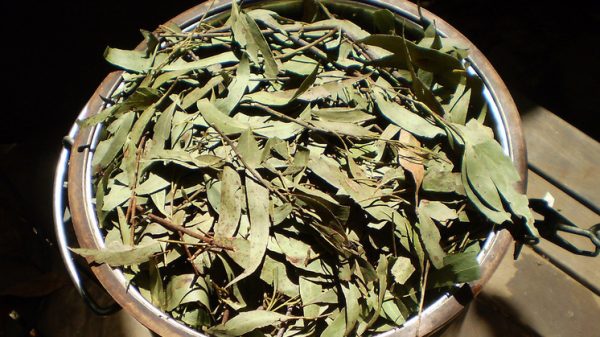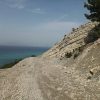Researchers have found a key clue
An unusual asteroid flying near Earth is believed to be a piece of the Moon, but exactly how it ended up in the solar system remains a mystery. Now researchers say they have found a key link in this cosmic puzzle.

The cosmic body known as 2016 HO3 is a rare quasi-satellite — a type of near-Earth asteroid that orbits the Sun. but stays close to our planet.
Astronomers first discovered it in 2016 using the Pan-STARRS, or Panoramic Survey Telescope and Rapid Response System, telescope in Hawaii, CNN reported. Scientists have named the asteroid Kamo'oaleva — a name that comes from a Hawaiian creation song that talks about a descendant traveling on its own.
While most near-Earth asteroids come from the main asteroid belt — between orbits Mars and Jupiter — new research has found that Camo'aleva most likely originated from the Giordano Bruno crater on the far side of the Moon, or the side that faces away from Earth, according to a study published April 19 in the journal Nature. journal Nature Astronomy.
This is the first time astronomers have traced a potentially dangerous near-Earth asteroid to a lunar crater, said lead study author Yifei Jiao, a visiting scientist at the University of Arizona's Lunar and Planetary Laboratory and a doctoral student at Tsinghua University in Beijing.
“It was a surprise, and many were skeptical that it could have come from the moon,” said study co-author Eric Asphog, a laboratory professor at the University of Arizona. – For 50 years, we have studied rocks collected by astronauts from the surface of the Moon, as well as hundreds of small lunar meteorites that were accidentally ejected by asteroid impacts from around the Moon and ended up on Earth. Kamo'oaleva is sort of the missing link connecting them both.
In addition to confirming Kamo'oaleva's potential connection to the Moon, the findings could ultimately lead to other discoveries, including about how the ingredients for life came to Earth.
Kamo'oaleva, whose diameter ranges from 46 to 58 meters, is about half the size of the London Eye, notes CNN. As it orbits, it passes within 14.5 million kilometers of Earth, making it a potentially dangerous asteroid that astronomers are keeping an eye on and learning more about in case it ever gets too close to our planet.< /p>
Previous studies have focused on the asteroid's reflectivity, which, unlike typical near-Earth asteroids, is similar to lunar materials, and the space rock's low orbital speed relative to Earth, suggesting it came relatively close.
For the new study, astronomers used modeling to determine which of the thousands of craters on the Moon could have been the site of an asteroid impact.
Based on modeling, the team determined that the impactor that potentially created the asteroid would have to be at least 1 kilometer in diameter to dislodge such a massive fragment. When the object crashed into the Moon, it likely dug up Kamo'oalevo from beneath the lunar surface, sending the space rock flying and leaving a crater ranging from 10 to almost 20 kilometers in diameter.
These calculations also helped the team find a relatively young crater, given that the asteroid is estimated to be only a few million years old, while the Moon is believed to be 4.5 billion years old.
These parameters helped the researchers select the 22-kilometer-wide, 4-million-year-old Giordano Bruno crater as the likely location where Kamo'oaleva began its journey.
The study's simulations showed that Kamo'oaleva was extracted from the lunar surface at a speed of several miles per second.
“You would think that the collision would have shattered the lunar material,” says Asphog. — But that's how it is. So we solved the problem differently and asked ourselves, “How can we achieve this?”
Based on their models, the team believes that the collision sent tens of hundreds of 10-meter fragments flying into space . However, Kamo'oaleva was preserved as a massive single fragment.
“Although most of this debris would fall to Earth as lunar meteorites in less than a million years, a few lucky objects may survive in sun-oriented orbits as near-Earth asteroids that have yet to be discovered or identified,” Jiao notes.
Understanding how such a giant piece of the Moon could remain intact enough to become an asteroid could help scientists studying panspermia, or the idea that the ingredients for life could have been brought to Earth in the form of «organic hitchhikers.» on space rocks such as asteroids, comets or other planets.
“Although Kamo'oaleva comes from a lifeless planet, it demonstrates how rocks ejected from Mars could carry life— at least in principle”, – Asphog emphasizes.
Studying the impact of craters on the Moon could also help scientists better understand the effects of an asteroid impact if the space rock poses a threat to Earth in the future.
“Testing a new model for the origin of Kamo from a specific young lunar crater opens the door to reliable knowledge of the damage that asteroid impacts can cause to planetary bodies,” study co-author Renu Malhotra, a professor of planetary sciences at the University of Arizona, said in a statement. .
China's Tianwen-2 mission, launching in 2025, will visit Kamo with the goal of collecting samples from the asteroid and ultimately returning them to Earth.
< p>“It will be significantly different from any of the samples we have— “This is one of those connecting elements that will help you solve the puzzle,” says Asphog.
Studying a sample recovered from the far side of the Moon could provide insight into a part of the Moon that has been less explored and shed light on the composition of its interior. Considering that the collision likely occurred several million years ago — relatively recently by astronomical standards, — the samples could also help scientists study how cosmic radiation causes asteroids to weather and erode over time.
«What's interesting is that when a space mission visits an asteroid and returns multiple samples, there are surprises and unexpected results that are usually beyond what we expected,» said study co-author Dr. Patrick Michel, an astrophysicist and director of research at the National Center for Science and Technology. scientific research in France. “So, regardless of whether Tianwen 2 returns, it will be a new extraordinary source of information, like all previous asteroid missions.”
For a long time, astronomers believed that meteorites could not come from moons until lunar meteorites were discovered on Earth, said Noah Petro, NASA's Lunar Reconnaissance Orbiter project scientist. and «Artemis III». Petro was not involved in the study.
It is hoped that future samples will be able to confirm the lunar origin of Kamo'oaleva.
“Going there and finding out is what needs to be done now.&rdquo “,” said Petro. “It's a great reminder that we live in a very interesting solar system, and we live in a very interesting corner of the solar system with our Moon. There is no other place in our solar system, no other planet with such a satellite as our Moon. And things like this are a great reminder of how special the Earth-Moon system is.”























































Свежие комментарии